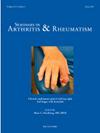累计终生雌激素暴露对绝经后类风湿关节炎妇女临床特征和病程的影响
IF 4.4
2区 医学
Q1 RHEUMATOLOGY
引用次数: 0
摘要
目的探讨累计终生雌激素暴露(CLEE)对类风湿关节炎(RA)病程的影响。方法对来自韩国关节炎观察性研究网络的2878名绝经后RA患者进行基线调查,随访5年。CLEEs通过结合生殖期和绝经后激素替代治疗的持续时间来计算。RA患者被分为高CLEE组和低CLEE组,平均年龄为34岁。结果在基线时,与CLEE较高的患者(n = 1179)相比,CLEE较低的RA患者(n = 1602)表现出更高的疾病活动性和更多的影像学糜烂。在基线时,低CLEE组在疼痛、疲劳、睡眠障碍、功能障碍、健康相关生活质量和RA总体评估方面的患者报告结果(PROs)比高CLEE组更差(所有P <;0.01)。在调整混杂因素后,CLEE较低的组在5年内显示简化疾病活动指数(SDAI)和健康评估问卷-残疾指数得分增加,eq - 5d效用值下降。在基线时患有RA和sda11的患者中,调整混杂因素后,CLEE较低的组获得缓解的可能性明显较低(HR, 0.597 [95% CI 0.421-0.848], p = 0.004)。结论与CLEE较高的RA患者相比,CLEE较低的RA患者具有较高的疾病活动性、更多的糜烂性疾病和更差的PROs。较低的CLEE会对疾病活动性和PROs的纵向变化产生不利影响,并与RA临床缓解的可能性较低相关。本文章由计算机程序翻译,如有差异,请以英文原文为准。
Effects of cumulative lifetime estrogen exposure on the clinical characteristics and courses in postmenopausal women with rheumatoid arthritis
Objectives
To assess the effect of cumulative lifetime estrogen exposure (CLEE) on the course of rheumatoid arthritis (RA).
Methods
A total of 2878 postmenopausal women with RA from the Korean Observational Study Network for Arthritis Cohort were investigated at baseline and followed for 5 years. CLEEs were calculated by combining the reproductive span and duration of postmenopausal hormone replacement therapy. Patients with RA were classified into higher and lower CLEE groups using a median of 34 years.
Results
Patients with RA and a lower CLEE (n = 1602) showed significantly higher disease activity and more radiographic erosion than those with a higher CLEE (n = 1179) at baseline. The lower CLEE group demonstrated worse patient-reported outcomes (PROs) for pain, fatigue, sleep disturbance, functional disability, health-related quality of life, and global assessment of RA than the higher CLEE group at baseline (all P < 0.01). The lower CLEE group showed increased Simplified Disease Activity Index (SDAI) and Health Assessment Questionnaire-Disability Index scores and decreased EQ-5D-utility values over 5 years after adjusting for confounders. Among patients with RA and an SDAI>11 at baseline, the lower CLEE group was significantly less likely to achieve remission after adjusting for confounders (HR, 0.597 [95% CI 0.421–0.848], p = 0.004).
Conclusions
Patients with RA and lower CLEE had higher disease activity, more erosive disease, and worse PROs than those with a higher CLEE. Lower CLEE adversely affects longitudinal changes in disease activity and PROs and is associated with a lower likelihood of achieving clinical remission in RA.
求助全文
通过发布文献求助,成功后即可免费获取论文全文。
去求助
来源期刊
CiteScore
9.20
自引率
4.00%
发文量
176
审稿时长
46 days
期刊介绍:
Seminars in Arthritis and Rheumatism provides access to the highest-quality clinical, therapeutic and translational research about arthritis, rheumatology and musculoskeletal disorders that affect the joints and connective tissue. Each bimonthly issue includes articles giving you the latest diagnostic criteria, consensus statements, systematic reviews and meta-analyses as well as clinical and translational research studies. Read this journal for the latest groundbreaking research and to gain insights from scientists and clinicians on the management and treatment of musculoskeletal and autoimmune rheumatologic diseases. The journal is of interest to rheumatologists, orthopedic surgeons, internal medicine physicians, immunologists and specialists in bone and mineral metabolism.

 求助内容:
求助内容: 应助结果提醒方式:
应助结果提醒方式:


